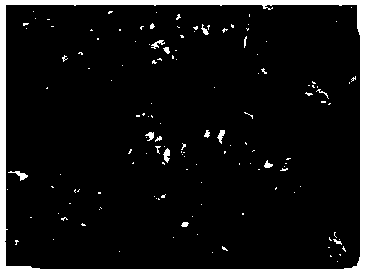Herbicide-resistant protein in Brassica napus and its application in plant breeding
A rape and plant technology, applied in the field of plant protein, can solve the problems of loss of herbicide resistance, complicated situation, and inability to apply in practice.
- Summary
- Abstract
- Description
- Claims
- Application Information
AI Technical Summary
Problems solved by technology
Method used
Image
Examples
Embodiment 1
[0035] Example 1 Extraction of protein mutants resistant to imidazolinone herbicides from Zhongshuang No. 9 mutant plants
[0036] Rapeseeds of various varieties / lines were sown, including Zhongshuang 9 (available from the Institute of Oil Crops, Chinese Academy of Agricultural Sciences). Before sowing, soak the rape seeds of each variety / line in water for 22 hours in an incubator at 25°C, then remove the seeds and control the water. Then, each canola seed was soaked with 0.4% (w / w) ethyl methanesulfonate (EMS) for 12 hours, during which the seeds were shaken every 1 hour. After 12 hours, discard the EMS solution, replace the tap water to soak the seeds, discard the tap water, and repeat the soaking 5 times in total, soaking for 5 minutes each time, then rinse the seeds with tap water for 2 hours, and turn the seeds during the rinsing process to wash off the EMS. Put a small amount of seeds on the surface of wet paper, put them in an incubator at 28°C, and measure the germi...
Embodiment 2
[0038] Example 2 Determination of in vitro activity of protein mutants against imidazolinone herbicides
[0039] Refer to the method of Fan ZJ et al. (Specific activity determination of acetolactate synthase from maize (Zea mays L.). See Han WN et al. The Proceedings of the 18 th Asia-Pacific Weed Science Society Conference . 515 - 522 . May 28 -June 2, 2001. Beijing: Standards Press of China.), extracted the ALS enzymes of the above-mentioned Zhongshuang 9 wild-type and mutant plants, and determined the rate of inhibition of the corresponding enzyme activity by imidazolinone herbicides. Briefly speaking, 5 g of each plant seedling was taken and chopped, and 10 mL of 50 mmol / L K at pH 7 was added. 2 HPO 4 -KH 2 PO 4 Buffer (containing 1 mmol / L sodium pyruvate, 0.5 mmol / L MgCl 2 , 0.5 mmol / L TPP, 10 μmol / L FAD), ground and pulverized with quartz sand, filtered with 8 layers of gauze, and the filtrate was centrifuged at 4°C and 20,000 rpm for 30 minutes. Take the supernat...
Embodiment 3
[0043] The acquisition of the transgenic plant of embodiment 3 transprotein mutant gene
[0044] The gene encoding the above-mentioned mutant ALS enzyme of Zhongshuang9 was transformed into wild-type Arabidopsis plants by conventional Agrobacterium-mediated method. In short, use the forward primer (5'-catcatctctctctcctctaaccatggc -3') and the reverse primer (5'-CCAGCTTCATCTCTCAGTACTTAG -3') to PCR amplify from the genomic DNA of the mutant plant of Zhongshuang9 above. After the mutant ALS gene was sequenced correctly, the nucleotide sequence of the ALS gene shown in SEQ ID NO: 1, 3, 5, 7, 9 and 11 was cloned into the pCAMBIA1303 plasmid (purchased from Cambia Company), and positive clones were selected Transform Agrobacterium EHA105, culture the cells and transform Arabidopsis thaliana. The positive Arabidopsis thaliana was harvested by PCR to obtain transgenic seeds of the T1 generation, and sprayed with imidazolinone herbicide "imazapyr" water agent when planting , it was...
PUM
 Login to View More
Login to View More Abstract
Description
Claims
Application Information
 Login to View More
Login to View More - R&D
- Intellectual Property
- Life Sciences
- Materials
- Tech Scout
- Unparalleled Data Quality
- Higher Quality Content
- 60% Fewer Hallucinations
Browse by: Latest US Patents, China's latest patents, Technical Efficacy Thesaurus, Application Domain, Technology Topic, Popular Technical Reports.
© 2025 PatSnap. All rights reserved.Legal|Privacy policy|Modern Slavery Act Transparency Statement|Sitemap|About US| Contact US: help@patsnap.com

